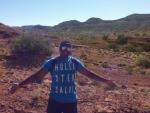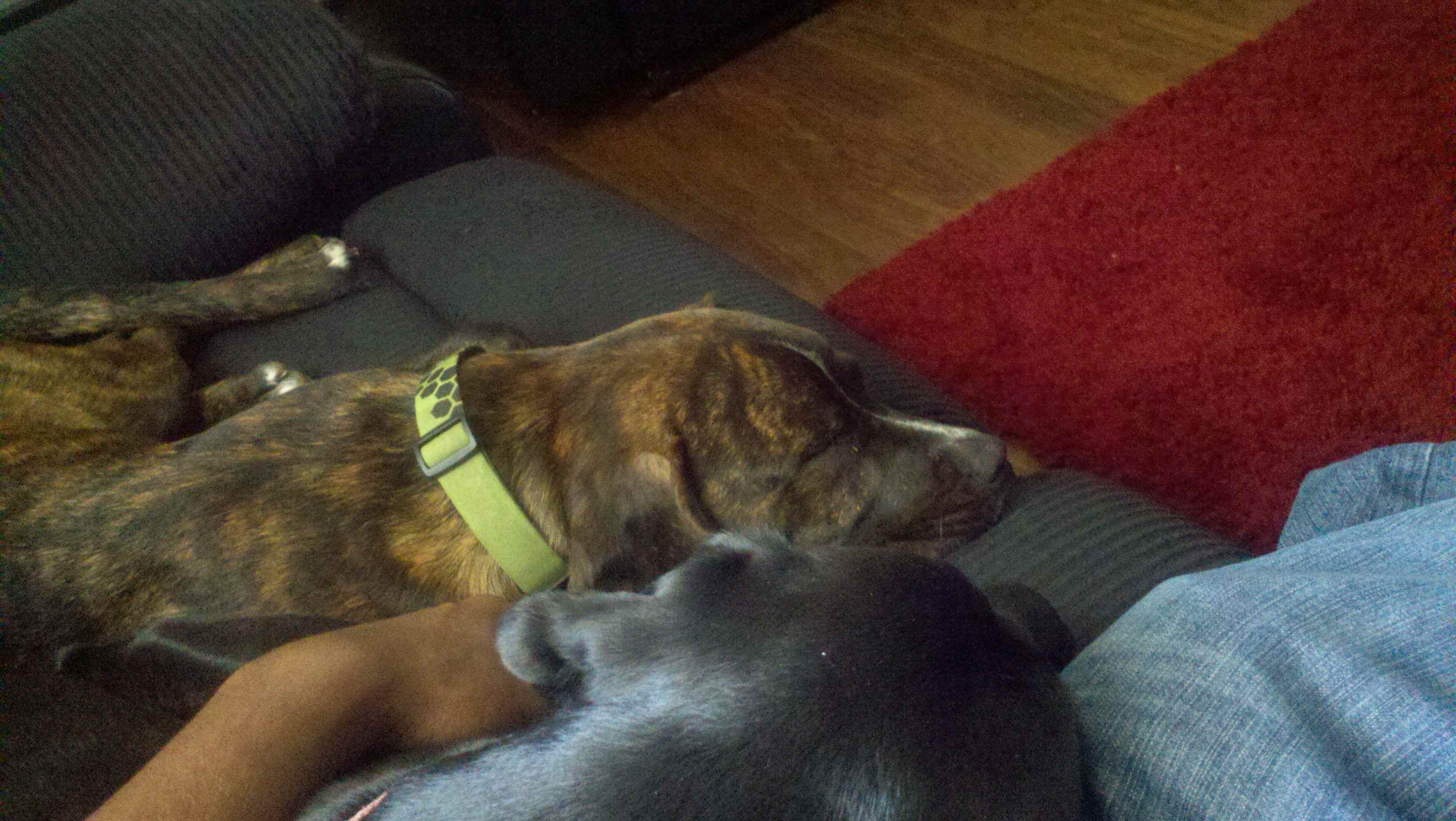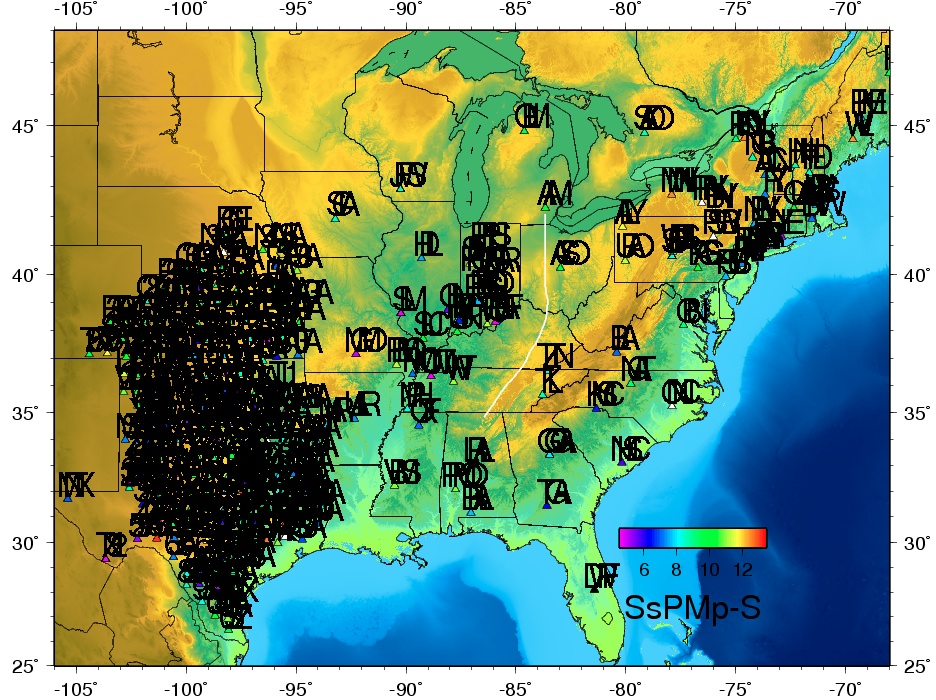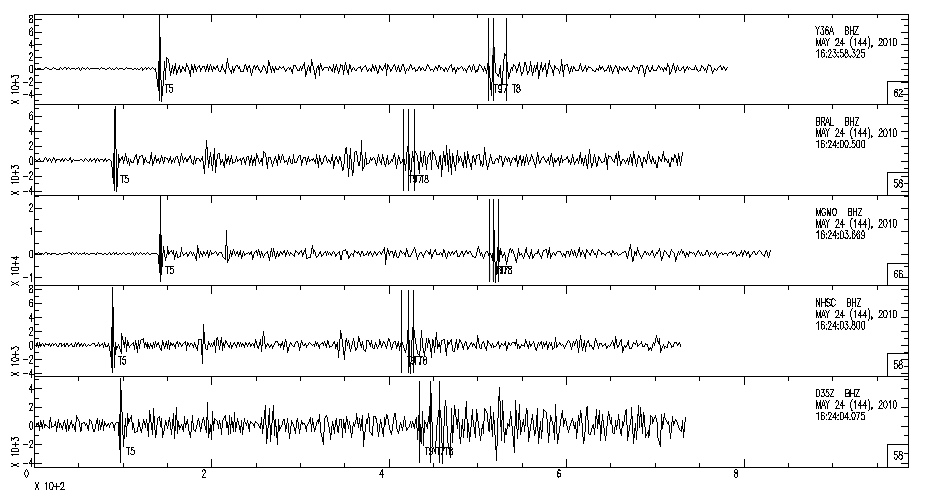Calvin Johnson

Calvin Johnson is a student at Fort Valley State University currently completing his research at MIami University under Dr. Mike Brudzinski.
Overcoming the Final Leg
July 20th, 2012
Hi World!
So this is my last week in Oxford before I leave to Penn State :’(, but I’ll still continue to work on the project throughout my stay there and the school year because I want to make my mark in the scientific community. These past few weeks I’ve been comparing my data with my mentors data and learned a new feature on SAC that actually helped me out 10x’s better than actually making my picks one by one with 4 different events. This feature is called relative plotting or p1 rel/p1 r. It actually aligns the seismograms from a receiver station that you choose to view according to which ever pick you desire, but this is accompanied with the feature xlim, which puts limitations by your desire on how many seconds of the seismogram you want to view out from the pick of your choice.
Sounds complicated? Nooo, that’s the easy part. The hard part was trying to homogenize my own data so I can see some type of trend then compare it to other maps to see if they appear to be similar. This called for (literally) over a thousand commands of chmod +x (to renew my maps) and map.sta.csh 1, 2, 3, 4….. lets just say I’m glad I’m almost done. The tricky part about homogenizing the trends of these maps was that a slight misalignment of the SsPmp picks on the seismogram and the trends on your maps off of the same station would look foreign from each other. In some instances I had stations that wouldn’t show at all, like really, one station totally disappeared.
After I finished the homogenization I then began to compare my data to Mike’s and luckily the appeared to be somewhat similar to each other. (Another note, I learned the difference in Amplitude in a seismogram could make a huge difference in comparisons). Now all I’m waiting for is the program that will help me convert these time arrivals to actual depths so we can get a profile view of the actual structure of the Eastern U.S. I’m so excited! This study can go so many different ways and I’m just glad to be the person that contributed to this fairly young study in the Eastern U.S. I’ve began writing my paper and I pretty much have my abstract already mapped out, all I need is my final figure and I’m done.
As for life these past couple of weeks, Noor held two gatherings at her house, Burrito night and Megan’s (her close friend) Birthday. I loved both events and the company from Jared (freaking hilarious) , Yi (most friendly person I know…. In life), Sarah, Katie, and her boyfriend Scott (he’s a cool dude). Oh! And Noor just pointed it out to me the other day that her shirt was missing…. See facebook and social networking for me is not my key strength, I’m old school, just call or text me lol. On a good note, we’re taking pictures tomorrow with the shirts on and I’m going to post it on my next blog. I can’t wait to see you all (IRIS Interns) at AGU, its going to be fun! Well that’s about it for me, and Noor if I forgot something that we did please comment and let me know, also world, if you have any questions comment me, email me @ Saro357@yahoo.com or CalvinJohnson357@gmail.com. Also! I’m starting a paper because I want to work towards getting it published! An update on the USArray won’t hurt the society.
Thank you all for reading and God bless,
Sincerely,
Calvin E. Johnson
Week 6 and Lucky #7
June 28th, 2012
Hi Everyone,
Sorry for the delay, but everything is ok. These last two weeks have been intense, and if you all don’t know yet I’ve been fasting for these past two weeks. It has been a great experience so far, and I learned quickly that the first thing you can’t do is skip out on a drink or meal. So far I have been analyzing 900 seismograms from approximately receiver stations 300, and I should say that it is a timely process. The four earthquakes that I’m focusing on is the Western Brazil in 2010 (6.2 Mag. occurred at a depth of 581.20m), Peru-Brazil border in 2008 (6.4 Mag. occurred at a depth of 154.0m), Peru-Ecuador border in 2007 (6.8 Mag. occurred at a depth of 122.9m), and another EQ from Western Brazil that occurred in 2002 (6.9 Mag. Occurred at a depth of 534.3).
I had the opportunity of utilizing SAC in order to indicate where the P (T5), sp, (T9) S (T7), and SsPmp (T8) arrival times are located. After analyzing all 900 seismograms and picking the arrival times, I assumed that I was finished with the majority of the work, on the contrary, no, I had to then compare the bulk of my seismograms with Mike’s seismograms. I did this task by plotting my time offsets and comparing them to Mike’s time offsets, how did I do this you ask? I honestly didn’t, the program (which is EXTREMELY complex) was already prewritten in order for me to run my time arrivals through the program and create plot with the different magnitudes that occurred across the nation. When I ran the program for the first time I realized that I wasn’t near the finish line yet. In comparison to Mikes plot, his was colorful and revealed some type of trend, mines was a colorful with a bunch of black triangles and no trend (the black triangles = I didn’t pick a SsPmp time arrival for that station in that data set because it wasn’t clearly visible). Therefore I had to go through all of the seismograms and pick/re-pick the SsPmp time arrivals.
We also had the chance to review a paper written by Gregory C. Beroza on Slow Earthquakes. In all, and I encourage you all to read this paper, it was conveying that slow-slip events (SSE), episodic tremor and slip (ETS), tremor, low frequency events (LFE), and very low frequencies (VLF) correlate with the occurrence of slow earthquakes. The results gives the reader more of an understanding of how a slow-slip event can only occur if you have tremor, which me personally I don’t believe, but the author goes on to reveal that there is some deviation between the source of the tremor and slow-slip events (i.e. love waves, tidal forcing, weak faults, etc.), and that even though the slow earthquakes occurred in a deep extension of major faults in this study they can possibly occur in more shallow depths in the near future. It also point out that Slow Earthquakes usually occur in younger sediments.
But enough about that, if you’re interested in reading it just email me at Saro357@yahoo.com, otherwise, I’m going to continue to tell you all about my 2 weeks. Lately everybody in the office have been busy, but the week was a turn for the better. I had the chance to go to an ice cream social, then right after that I went to a club with Noor and Yi (a lovable Chinese student I met up here) named The Brick. It was a great experience, and I’ve been trying a bunch new things up here, for instance, cooking more than I usually do and…. Oh yea, FASTING. Also, my roommate Harmony adopted a puppy and he’s the best puppy you can have. Here’s a picture of him, and also of some of my work



Well that’s all for this week, Oh! I almost forgot, Mike was successfully able to permit an EarthScope Transportable Array site on the edge of Miami’s campus. They have already constructed an underground “vault” at this site, they just need to install the equipment this tomorrow and I’ll be involved in this epic event. I’m so excited. I hope you all enjoyed my blog, God bless, and let me know if you have any questions.
Sincerely,
Calvin E. Johnson
The Seis of your Ambition Matters the Most
June 9th, 2012
Hi World,
Sorry it took me sooo long to get back with you all, but I've been through a lot these past 4 weeks. Ok so where should I start? Oh!
Week 2: I finally finished the UNIX/LINUX tutorial, but my victory was short lived because I had another program, Seismic Analysis Code (SAC), and my Great Grandmother that I mentioned in my previous post died….. a day before her birthday. So I spent the rest of the week at home preparing for her funeral. Really don’t have much to say on that.
Week 3: I returned to Oxford with much love from Shasta and Harmony, did I mention Shasta? She’s Harmony’s black dog and she has a strong personality, it’s crazy but it’s nice. Thing began to pick up with the SAC tutorial and the preparation for the next week, which was our orientation week for IRIS in Socorro, NM. The SAC tutorial was not that difficult, it just obtained a few bugs in it that I needed to establish with Mike. Who is Mike you ask? Well Mike Brudzinski is my mentor for the summer who is heading my research on the upper crustal region in the U.S. eastern coast, also the best person you’ll ever meet. I’ve began to work with Wilber II, and learned how to receive certain data sets from the system and have them custom made with the filters that I desire. My week was so busy to the point where I almost finished my tutorial, but I had to get ready to leave to NM. I’m one step away from getting to actually play with my own data and begin to develop my synthetic and observational plots.
Week 4: Everyday has a story for this week, and I can really say that I made 20 plus new friends this week. Sunday afternoon I arrived to the airport in Albuquerque and the landing was insane because once you come in there is an Air Force base right next to the airport so the commercial planes cannot fly over the restricted area. The plane had to fly around at full speed and make the landing, like a boomerang, crazy is it? When I arrived I felt like I was in San Antonio, TX all over again, cowboy hats and boots, and Native American pictures and music. After an hour, I met 4 of the IRIS interns, Dulcie, Lily, Anna, and Leah, and we were off to Socorro. When we arrived we met up with the rest of the 10 interns, and got to know each other quick by some brief introductions. We went to Rick Aster’s house right after that and had dinner, including a couple of introductory games, and a Bonfire!!! It was my first bonfire ever, I loved it, and the bonding time was great. We were involved with a lot of fun events that week, but the highlights of the week were the fieldtrips, the funny moments (there were A LOT), and the cookouts, dinners and SNACKS. The three places we went to in NM were: the Socorro Fault/Quebradas, the Magdalena Ridge, and the San Lorenzo Canyon. We learned a lot about the faults and displacement of the rocks and we hiked a grand total of 11 miles in one week. I learned a valuable lesson that week, and that was to always apply sunscreen. The week was action packed, so I’ll post that in the next blog, also, I’ll add my own exhaustive schedule to the schedule that was provided by IRIS/Michael Hubenthal. My outlook on the week is that I enjoyed it, and I have never experienced such an eventful and entertaining week in my life. That week alone has convinced me to come back to IRIS, and I’m glad to have been apart of that orientation week. The 17 interns IRIS that were there were (including myself), Katie, Rob, Noor (the funniest southeastern chick I know, also my partner in Oxford), David (my roommate who was hilarious, coolest guy you can meet), Greg (studious, laid back, huge and athletic), Ryan (reminds of me of my best friend back at home and he’s also hilarious), Erin, Leah, Dulcie, Amanda, Lily, Eva, Ayla, Rachel, Anna, and Maya. Everybody that don’t have a description by them I can say the same thing for them, i.e. amazing, athletic, extremely smart and attentive, and the best combination of friends that a Georgian like myself could have. David, Greg, and Ryan were my roommates in NM, and Noor will leave a great lasting impression in anyone’s life. Also, here are some new things I tried during the week: golfing, real rock climbing, real hiking, MATLAB, SV, FV, setting up geophones, and humus. Best week ever.
(go to http://ceejay357.posterous.com/the-seis-of-your-ambition-matters-the-most to see photos)
WEEK 5: Ok, this week I finished the SAC tutorial and now I’m beginning my analysis of the Eastern U.S. crustal structure using regional network recordings of Wide angle MOHO reflections. Monday, I had the opportunity to take a tour of the city from Noor’s perspective, and went to the movies. I was in the office for the rest of the week. The majority of my data appears to have a consistent trend, but some stations either recorded a bunch of noise or have an irregular trend. I used a BandPass filter and removed the mean for all of the data. I’m currently labeling the S, P, Sp, and SsPmp waves of the plots. I have 325 stations to go so I’m currently finishing that. I’ll update you all on the next data set that I have to analyze. I also met two new friends this week.
(go to [url=http://ceejay357.posterous.com/the-seis-of-your-ambition-matters-the-most]http://ceejay357.posterous.com/the-seis-of-your-ambition-matters-the-most[/url] to see photo)
Well that's all for today, I'll keep you all updated on the rest. Take care!
Best Wishes,
Calvin E. Johnson


